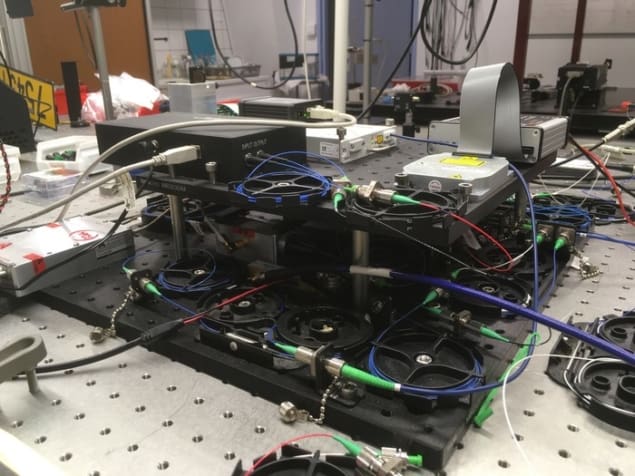Photonic system is very good at locating radio transmitters
31 Mar 2022

A new analogue photonic platform that can rapidly identify the locations of radio-frequency sources has been unveiled by Guillaume Bourdarot, Jean-Philippe Berger and Hugues Guillet de Chatellus at Université Grenoble Alpes–CNRS in France. Their device works by cross-correlating the signals detected by a pair of antennas and operates over a wide bandwidth. The system is low-cost and uses off-the-shelf components. Potential applications include radio astronomy and telecommunications.
Cross-correlation is a useful technique for measuring the similarity between two or more signals. When signals originating from the same source are detected by two spatially separated antennas, their similarity can be calculated as a function of the relative time delay that occurs if one source is closer to one antenna than the other. This this enables a cross-correlation system to identify the location of the emitting source.
The cross-correlation of radio-frequency signals can be done using either digital or analogue techniques – but each of these has its own intrinsic limitations. In a digital correlators signals must fist be digitized and this makes it difficult to analyse real-time signals with bandwidths exceeding a few 100 MHz. This limit does not apply to analogue systems, but they have different constraints associated with the limited performance of their radio-frequency components.
Promising alternative
Photonic devices use light to process information and have emerged as a promising alternative to the analogue processing of wideband radio-frequency signals. These systems take advantage of the huge bandwidth of the optical spectrum, as well as the availability of cheap, high-performing optical components. In its study, the Grenoble team used these advantages to develop a new correlator architecture, based on a simple photonic platform.
Featuring no moving parts, the team’s system uses a pair of frequency-shifting fibre optic loops to up-convert radio-frequency signals into optical frequencies. It can simultaneously calculate the cross-correlation function for 200 time-delay intervals – which is many more than previous photonic systems. This means that the technique can be used to locate time-dependent signals.
Furthermore, the platform’s time-delay step can be adjusted over several orders of magnitude: ranging from nanoseconds down to just picoseconds. This means that radio frequencies ranging from megahertz to several gigahertz can be processed.READ MORE

Once the cross-correlation function as calculated, it is then converted into a digital format for further processing. When tested, the system was able to locate a radio-frequency transmitter at 1 m distance from two receiving antennas a precision of about 3 mm.
The system could have important applications in astronomy by allowing researchers to cross-correlate signals detected by multiple radio telescopes in real time. The team is planning to use two antennas to capture gigahertz signals emitted by the Sun; and then cross-correlate the signals to produce radio-frequency images of the Sun.
Through further adjustments, the team hopes that their photonic platform could correlate signals from three or more antennas at once – enabling the 3D localization of emitters such as mobile phones, tracking tags, and signal jammers.
The research is described in Optica.
Sam Jarman is a science writer based in the UK.
FROM PHYSICSWORLD.COM 4/4/2022
Δεν υπάρχουν σχόλια:
Δημοσίευση σχολίου